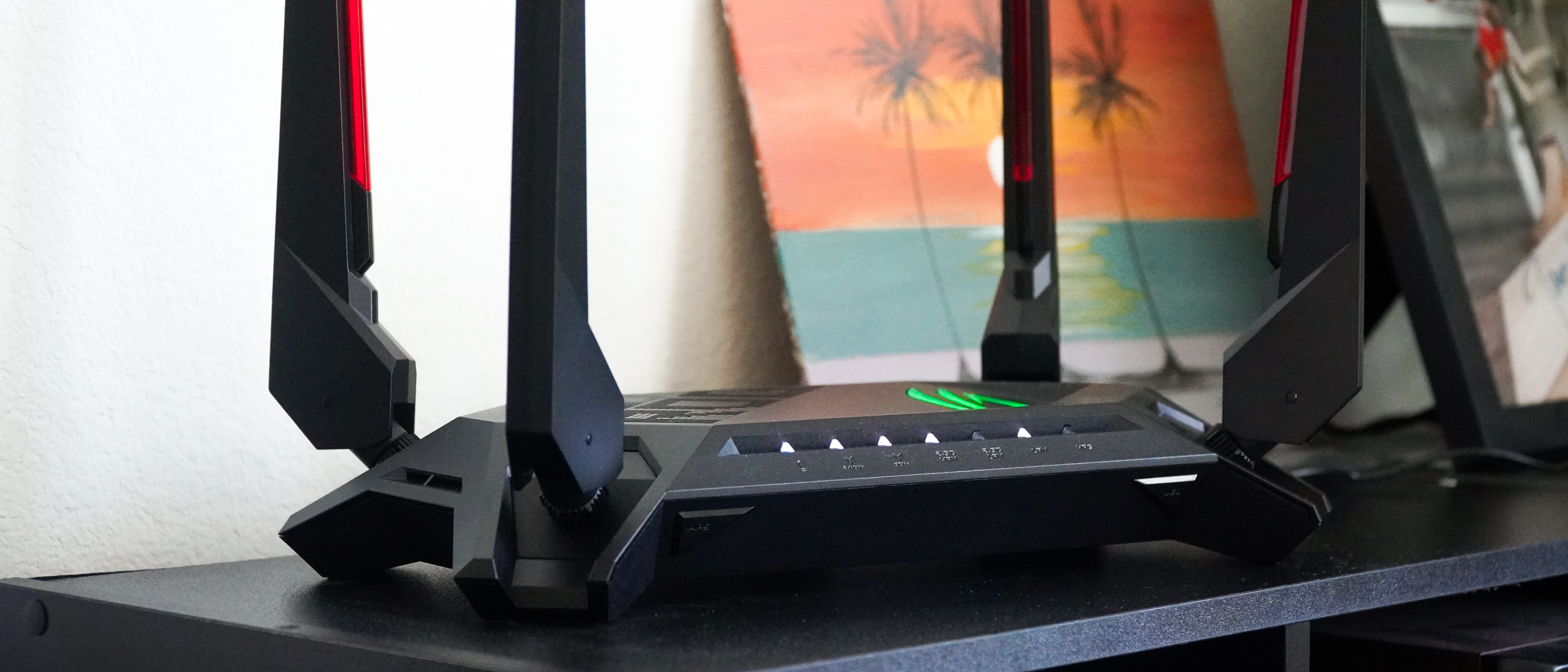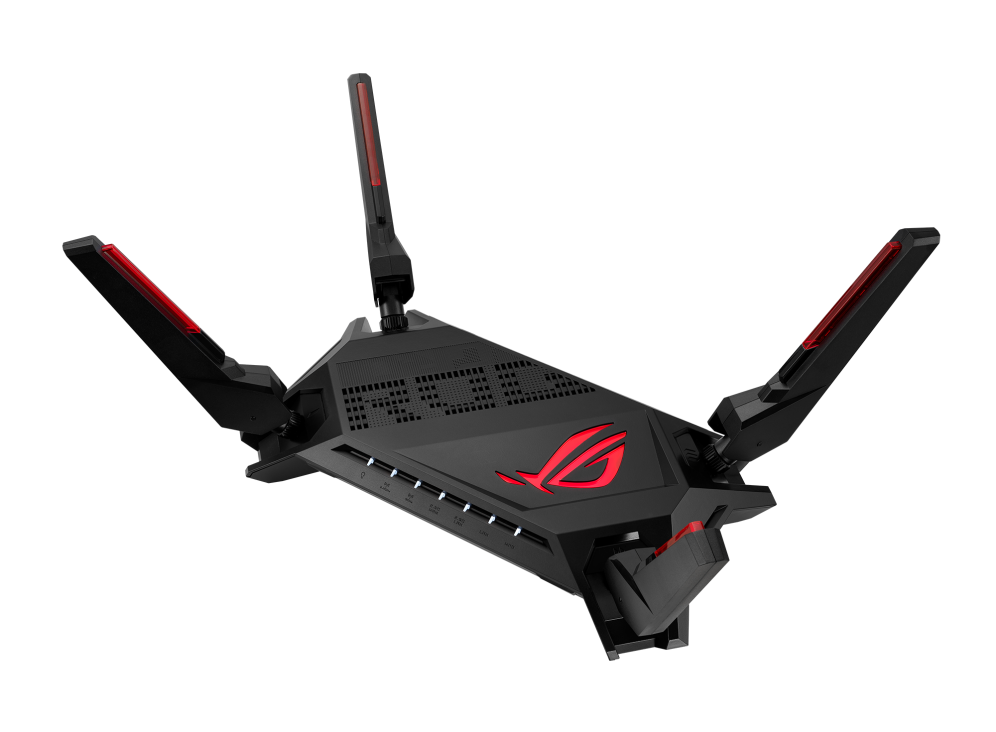Android Central Verdict
When it comes to performance, nothing about the ROG Rapture GT-AX6000 disappoints. While it looks like a robot prop designed for and rejected from a Star Wars movie, its large antennas and elevated stance give it excellent coverage and speeds all over my home. Its gaming software is some of the most advanced in the industry, with in-depth NAT controls, VPN Fusion, and prioritized devices and ports for gaming.
Pros
- +
Very fast AX6000 connection
- +
Good coverage with four large antennas
- +
Software and hardware gaming optimization included
- +
AiProtection brings security and parental controls for free
- +
AiMesh makes expansion easy and cheap
- +
Multi-gig Ethernet is great for LAN connections
Cons
- -
Very large and somewhat garish
- -
Only dual-band
- -
Expensive if you don't need the wired performance
Why you can trust Android Central
The ROG Rapture GT-AX6000 is a surprisingly fast router that exceeded my expectations in nearly every category. This is not the first AX6000 router I’ve tested, and it’s also not the first router I’ve tried with dual multi-gigabit Ethernet ports. It is, however, one of the most performant routers I’ve used with impressive speeds across my entire home. Most importantly, it handled a very important task very well — a week’s worth of Elden Ring online gaming, streaming, and downloading.
I have a 50 foot cat-6 cable run from my gaming PC to my router that gets plugged in when local wireless traffic gets high and wireless performance starts to waver. I never went for it in my time testing the Rapture GT-AX6000, even when I was downloading a couple of large games. It’s hard to throw enough real-world data at modern Wi-Fi 6 routers to get anywhere near their peak throughput, so evaluation comes down more to consistency and coverage. The ROG Rapture GT-AX6000 never let me down on either.
ROG GT-AX6000 review: Price and availability
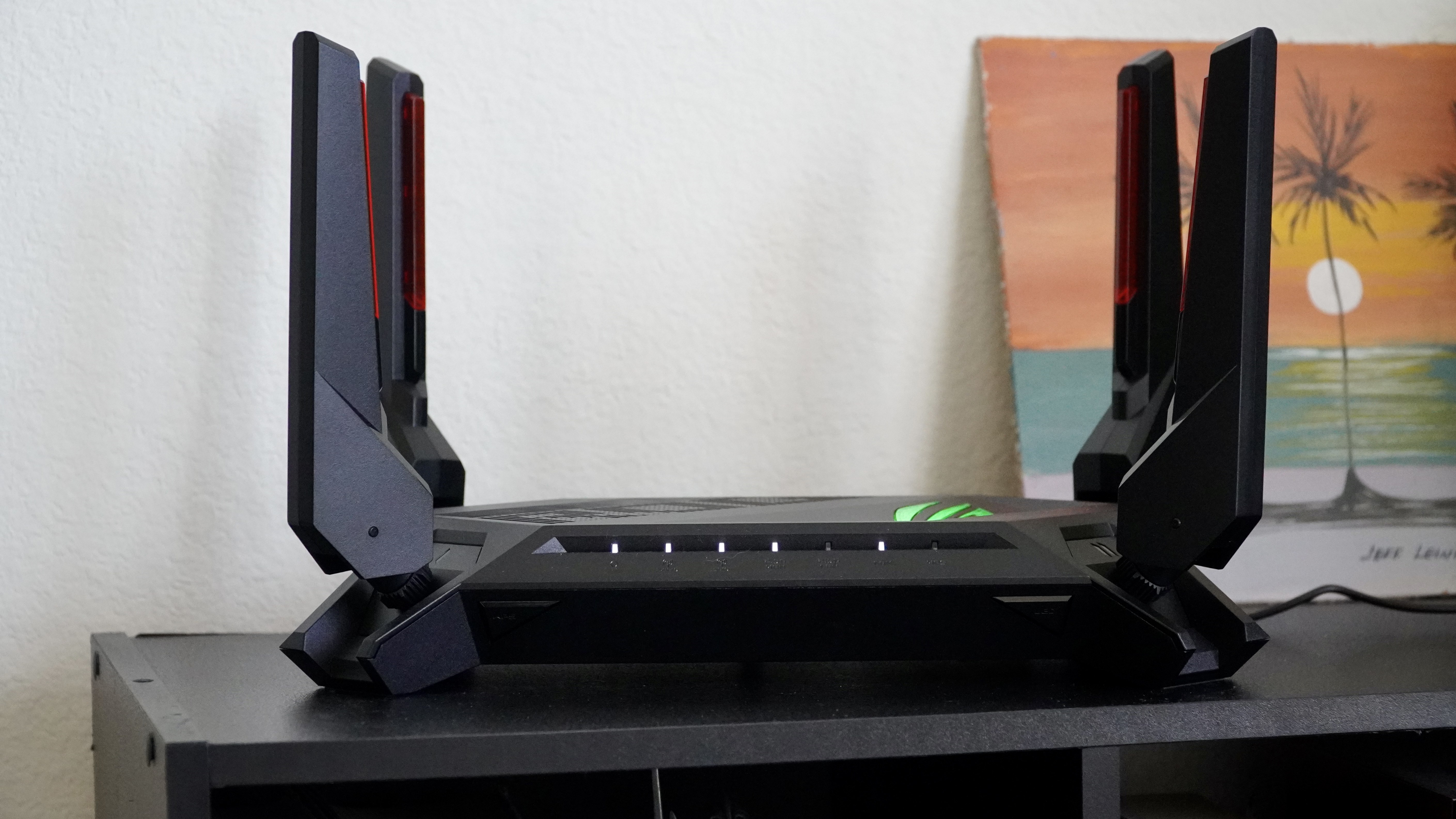
The ROG Rapture GT-AX6000 first became available in late 2021 at an MSRP of $399.99. This router is available in the U.S. at retailers like Amazon, B&H, and Newegg. It’s also available in several other countries worldwide though prices seem to favor the American market with lower average prices at current conversion rates. I tested this router with the newest available firmware version, 3.0.0.4.386_47629. Its possible performance could be affected by later firmware upgrades, but during my testing, the router was very stable, so I expect no major changes.
The router is packed in a cardboard box with a cardboard tray used for shipping protection, so it should be easy to recycle in even the strictest areas. The accessories are individually plastic-wrapped, including the power brick, power lead, and Cat 6 cable with metal tips. Overall, the packaging feels sufficient and reasonably eco-friendly.
ROG GT-AX6000 review: What I like
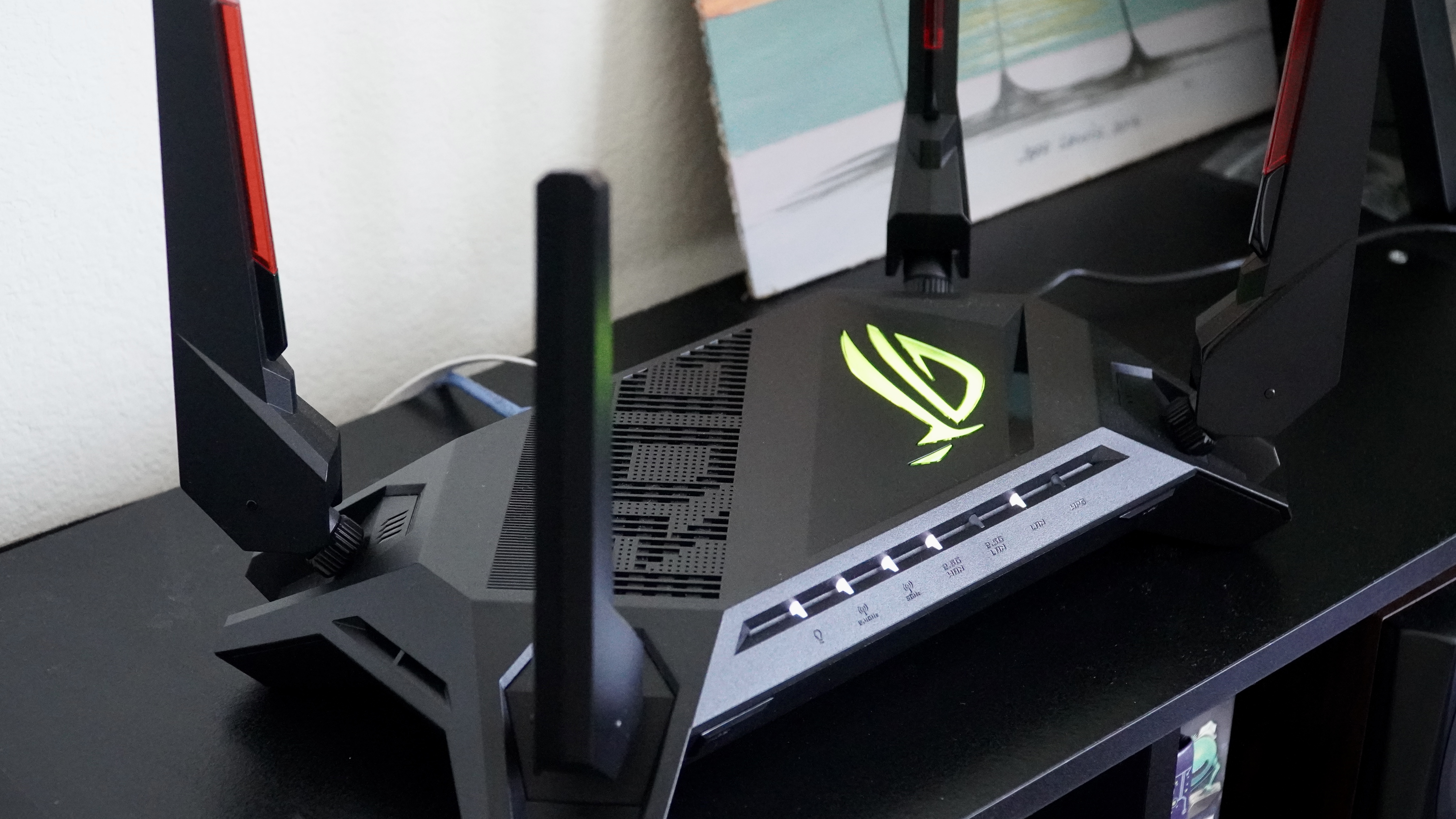
The Rapture ROG GT-AX6000 looks fairly standard from the spec sheet with a dual-band Wi-Fi 6 connection at AX6000 speeds with eight streams. The speeds break down to 4804Mbps at 5GHz and 1148Mbps at 2.4GHz. For the most part, Wi-Fi 6 devices will connect at 1201Mbps at 5GHz though some newer phones with 160MHz support, like the Zenfone 8, Galaxy S22 series, and Pixel 6 series of phones can connect at 2402Mbps. Other devices like the PS5 will be limited to 1201Mbps which is fine for the vast majority of internet connections.
This router also supports DFS channels for a bit more free air in congested areas alongside 1024 QAM and OFDMA for a more consistent connection when it must share spectrum with neighboring routers. This tech just allows the router to adjust its signal to avoid as much interference as possible when there are more routers in your area than available channels. This is even more important as 80MHz and 160MHz wide signals result in greater overlap than older setups.
On the wired side, this router is very powerful. There is a 2.5Gbps WAN port for your internet source, a second 2.5Gbps port for a fast wired device like a NAS, and four gigabit Ethernet ports for other devices. The first of the gigabit ports is prioritized for gaming, so if you have a gaming PC or console, this is where you should plug it for the best possible gaming connection.
This wired setup can be fantastic for a streamer that wants to quickly move large video files like high-quality stream archives from the primary streaming PC to a NAS. A potential setup could be using the streaming PC with a 2.5Gbps Ethernet connection and one of the best NAS setups for home, like the excellent Synology DiskStation 220+ using two of the gigabit ports with link aggregation for a 2Gbps connection. Then you can go edit from whatever device you want, be it a laptop with Wi-Fi 6 or even on your main gaming rig. There’s a good chance you won’t even notice a difference compared to local storage.

Even so, the raw power of this unit doesn't quite tell the whole story. The Asus product page for the Rapture GT-AX6000 claims that the new platform on this router increases throughput by 18% compared to the previous platform. While I don’t have the side-by-side equipment to fully test that claim, it did hold up very well when tasked with multiple large downloads, video streaming duty, and some online gaming.
My speed tests were performed on a gigabit connection from Cox with download speeds up to 940Mbps. Upload speeds were not recorded as the relatively low available upload speed of my connection was achieved on every test.
| Device | Living room (router) | TV room | Bathroom |
| Asus Zenfone 8 (Wi-Fi 6E) | 207Mbps 180Mbps | 206Mbps 206Mbps | 168Mbps 199Mbps |
| Galaxy S20+ (Wi-Fi 6) | 148Mbps 153Mbps | 156Mbps 159Mbps | 158Mbps 156Mbps |
| OnePlus Nord N200 (Wi-Fi 5) | 59.6Mbps 59Mbps | 61.4Mbps 68Mbps | 61.2Mbps 59.6Mbps |
Overall, 2.4GHz speeds were consistent enough for the devices that need the extra coverage on this band. Keep in mind that most 4K streaming services only require 25Mbps for full quality, so the speeds on this band should not be an issue.
| Device | Living room (router) | TV room | Bathroom |
| Asus Zenfone 8 (Wi-Fi 6E) | 811Mbps 815Mbps | 885Mbps 915Mbps | 437Mbps 601Mbps |
| Galaxy S20+ (Wi-Fi 6) | 697Mbps 693Mbps | 635Mbps 695Mbps | 560Mbps 511Mbps |
| OnePlus Nord N200 (Wi-Fi 5) | 319Mbps 321Mbps | 320Mbps 315Mbps | 231Mbps 229Mbps |
The 5GHz speeds were downright impressive. These download speeds stand toe-to-toe with much faster Wi-Fi routers, especially given that these tests were carried out during the day.
The Zenfone 8 connected at 160MHz with a link speed topping out at 2402Mbps, so it had the most headroom of the bunch. The S20+ uses only 80MHz Wi-Fi 6, so it didn’t have as much to work with but still turned in very strong numbers.
While the Wi-Fi 5 Nord N200 doesn’t look so impressive, its speeds are right in line with what I would expect from an entry-level device with a Snapdragon 480. A faster Wi-Fi 5 device, a MacBook Pro with a 1,300Mbps link speed, consistently turned in speeds over 700Mbps in the same room as the router.
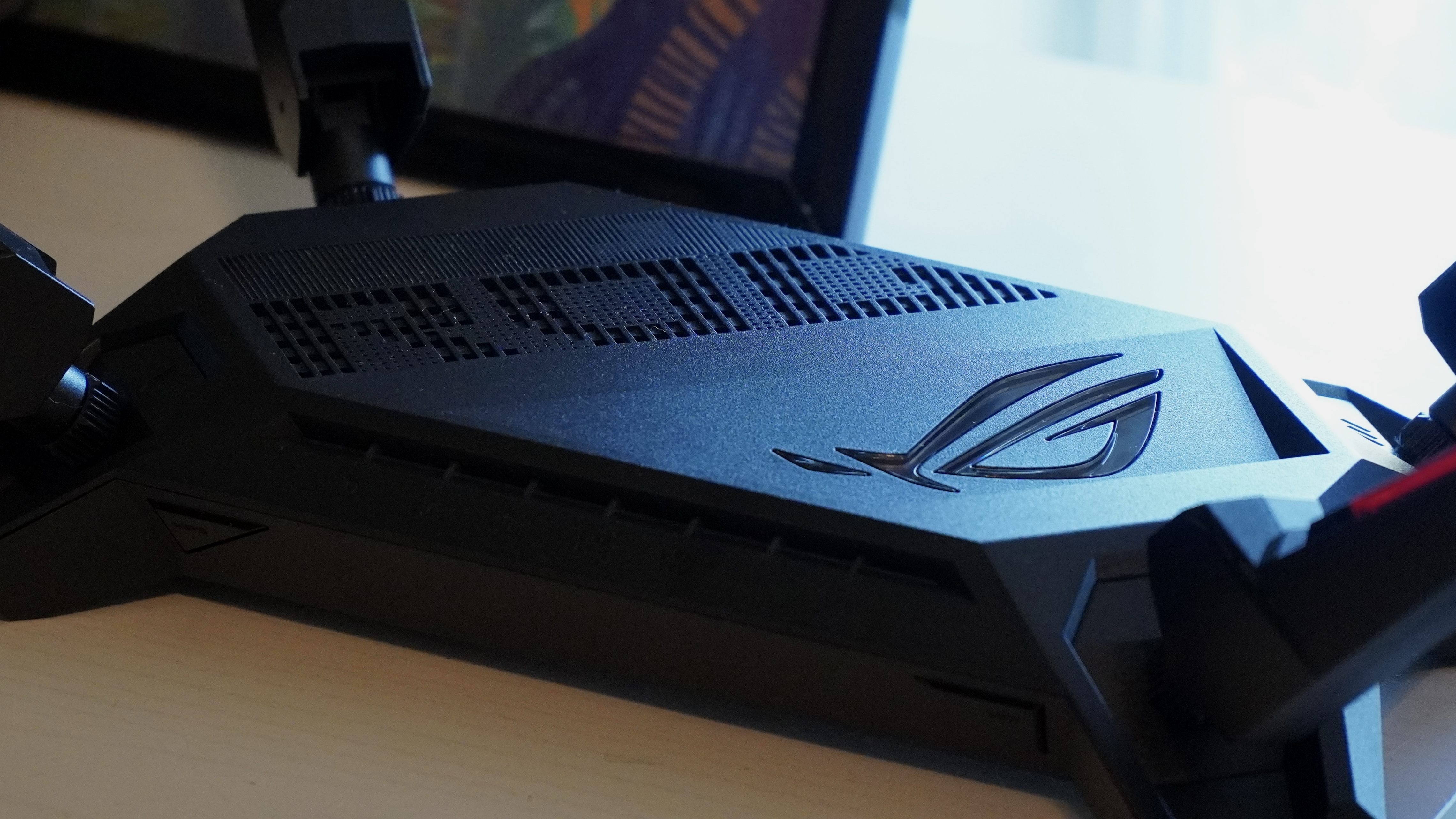
ROG stands for Republic of Gamers, so those buying this product will welcome the wealth of gaming features packed into the Rapture GT-AX6000. Asus calls its gaming setup Triple-Level Game Acceleration. It starts with device prioritization from both a software and hardware perspective. Next is game packet prioritization with its Game Boost, which prioritizes data transmitted by games to avoid lag spikes when multiple people are using your connection.
The final piece is a gaming VPN which allows you to connect to an optimal server for your connection. This can be helpful if you live in a country that doesn’t have a great connection to the closest server, which could lead to a matchmaking system putting you in high ping games. For example, someone in Australia may prefer a connection to US West over standard matchmaking for greater consistency. Asus links to VyperVPN for this purpose, but it must be noted that using a VPN can lead to greater ping times in gaming if your connection is already strong to a server.
Speaking of VPNs, Asus allows you to use your router with your VPN provider so you can have all of your devices connected to the internet through a VPN without needing to configure each one individually. This also means that devices without specific VPN abilities like game consoles can be used with a VPN. If, however, you don’t want all of your devices to connect to the VPN, such as a gaming PC where ping is important, you can use VPN Fusion to create device exceptions. Setup is easy and you likely only need to get an OpenVPN file from your VPN provider to get set up.
Asus also gives you in-depth NAT control, so your games can still work as expected if you’re connecting through an ISP-provided gateway. You can set up ports manually or simply add a premade profile from a list of popular games. For me, the default settings were not an issue.

Asus has also included its AiProtection security and parental controls. Partnered with Trend Micro, Asus gives this router the ability to block malicious sites from being accessed, block spam and DDoS attacks, and it can prevent infected devices from infecting your network. The parental controls can be set up for individual users with scheduling and content blocking appropriate for each. Long story short, the children can be blocked from reaching sites that aren’t appropriate, but Mom and Dad can continue unimpeded.
ROG GT-AX6000 review: What's not so great
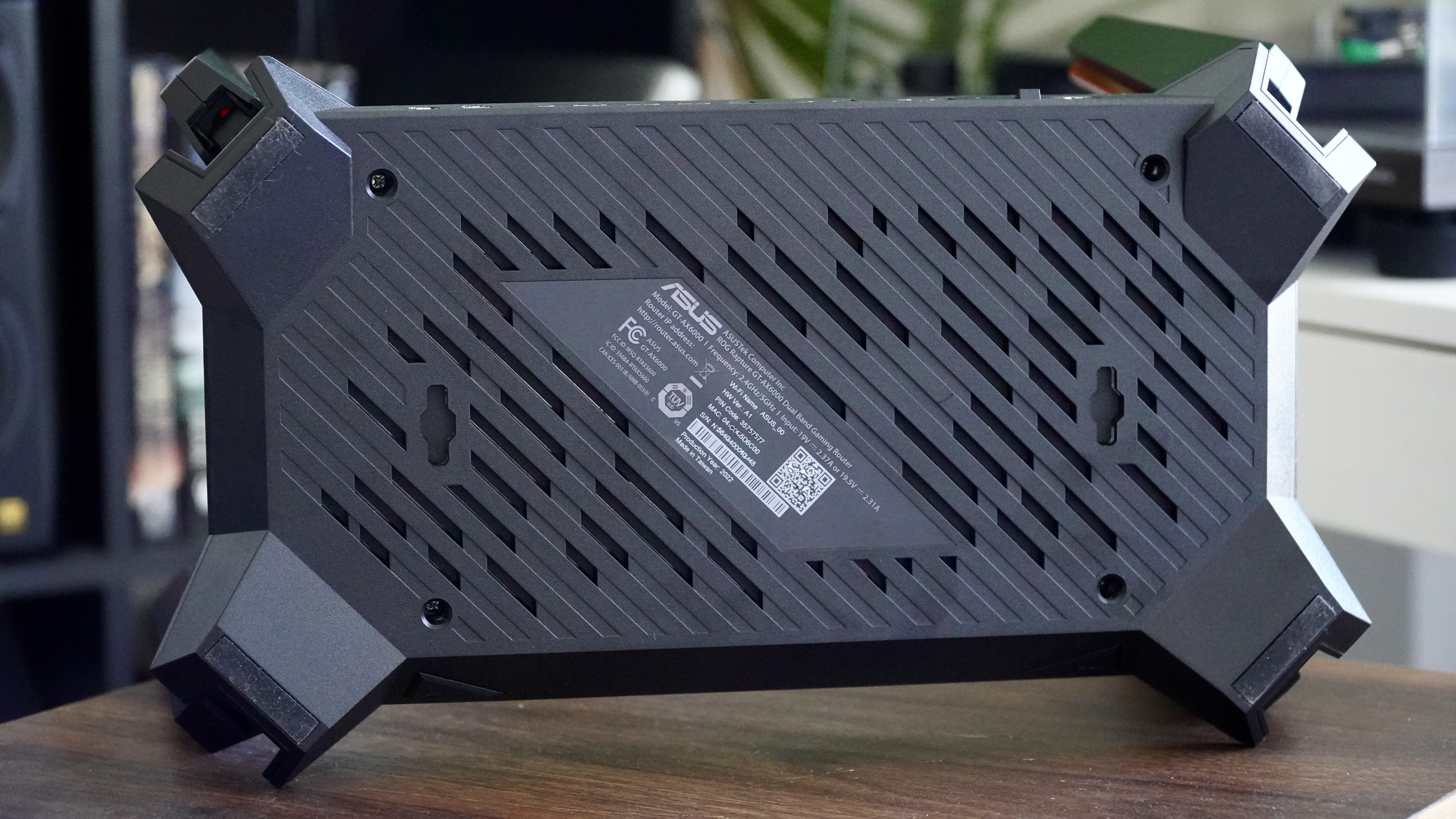
I kind of like the angular hardcore gamer design with the red accent pieces and RGB lighting, but a lot of people won't. That’s mostly okay since this is router is part of the Asus ROG brand but even for a ROG product, this one stands out. While a lot of people buying this router will have a gaming tower with RGB that fits in with this, if your internet access is in another room, it may not go with the rest of your decor.
Still, this isn’t really a con as much as something to consider before buying this model.
It’s also worth noting that this router is very large. Placed next to another AX6000 router, it's kind of a monster. It even stands taller than the insanely fast ROG Rapture AXE-11000. I do like that there’s space underneath for a bit of airflow and the quality of my Wi-Fi signal means that the large antennas are doing their jobs, but you need to keep in mind that if you have limited space, this router demands a lot of it.
ROG GT-AX6000 review: There's plenty of competition
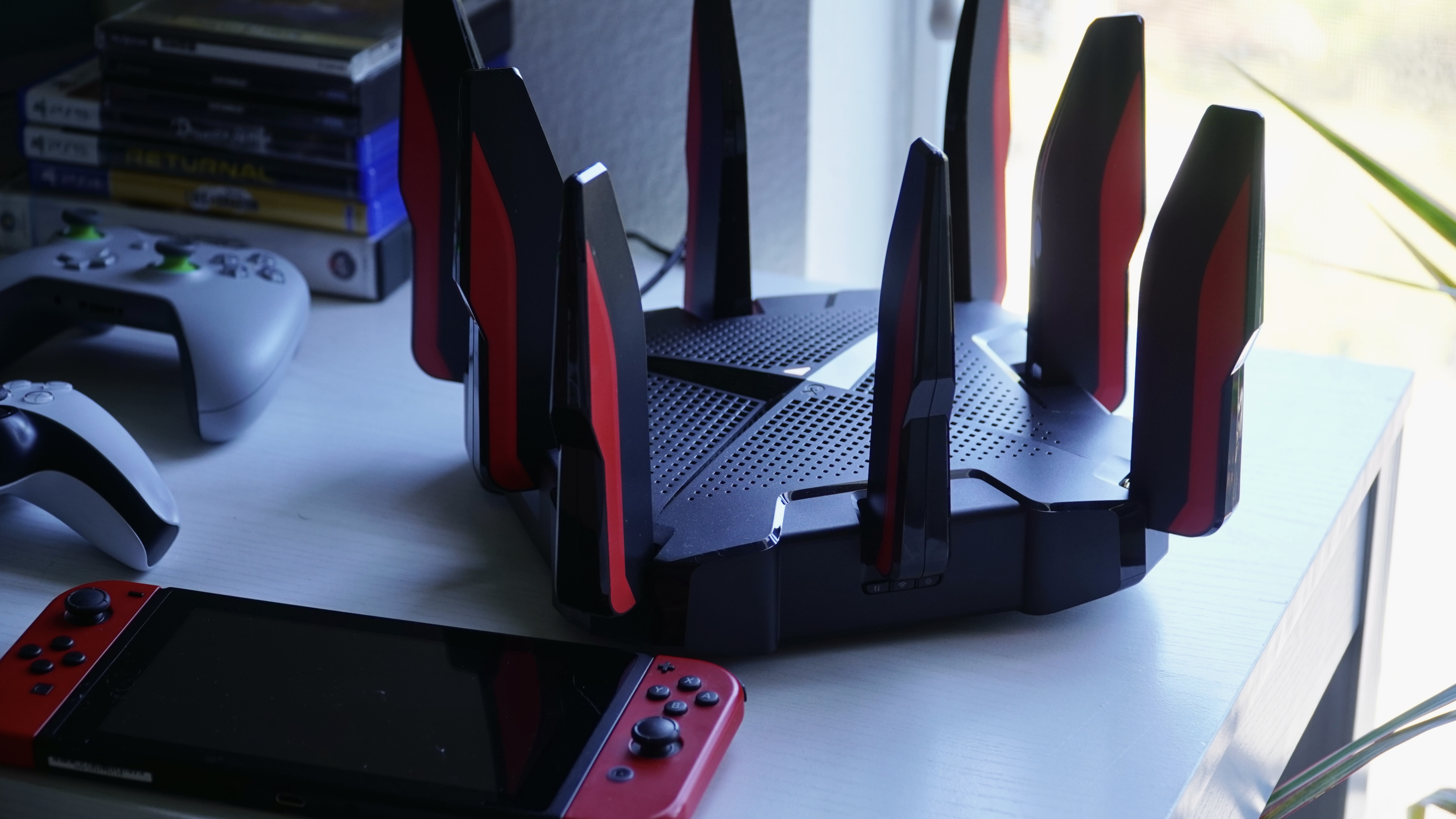
There’s no getting around that the ROG AX-6000 is a pricey router, and if you’re willing to give up a few of the features, like the dual multi-gig Ethernet ports, you can get a very good router for less. One of the first routers that comes to mind is the TP-Link Archer GX90. This tri-band Wi-Fi 6 router comes with a single 2.5Gbps Ethernet port but makes up for it by adding another 5GHz band to the mix. With 2.4GHz performance taking a bit of a hit, this will be fine for many people, and the dedicated Wi-Fi band for gaming could be a better fit for mobile-focused gamers. TP-Link’s HomeCare software also isn’t as robust as AiProtection if you’re interested in those software features.
The ROG GS-AX5400 is another router from Asus, but it’s a much more restrained design. Still, for most people, this router should provide more than enough performance for one or two gamers in a home. Ethernet ports are limited to gigabit, so you’re giving up some wired performance as well as cutting the 2.4GHz wireless performance in half. If you don’t need the extra capacity from Asus’ newer chipset and design, this is a great router.
When it comes down to it, the average gamer really doesn’t gain too much from buying a specific gaming router, with most of the other best Wi-Fi 6 routers packing in a sufficient QoS setting for gaming. Asus’s software still sets itself apart in just how many options you have when it comes to controlling your connection.
ROG GT-AX6000 review: Should you buy it?
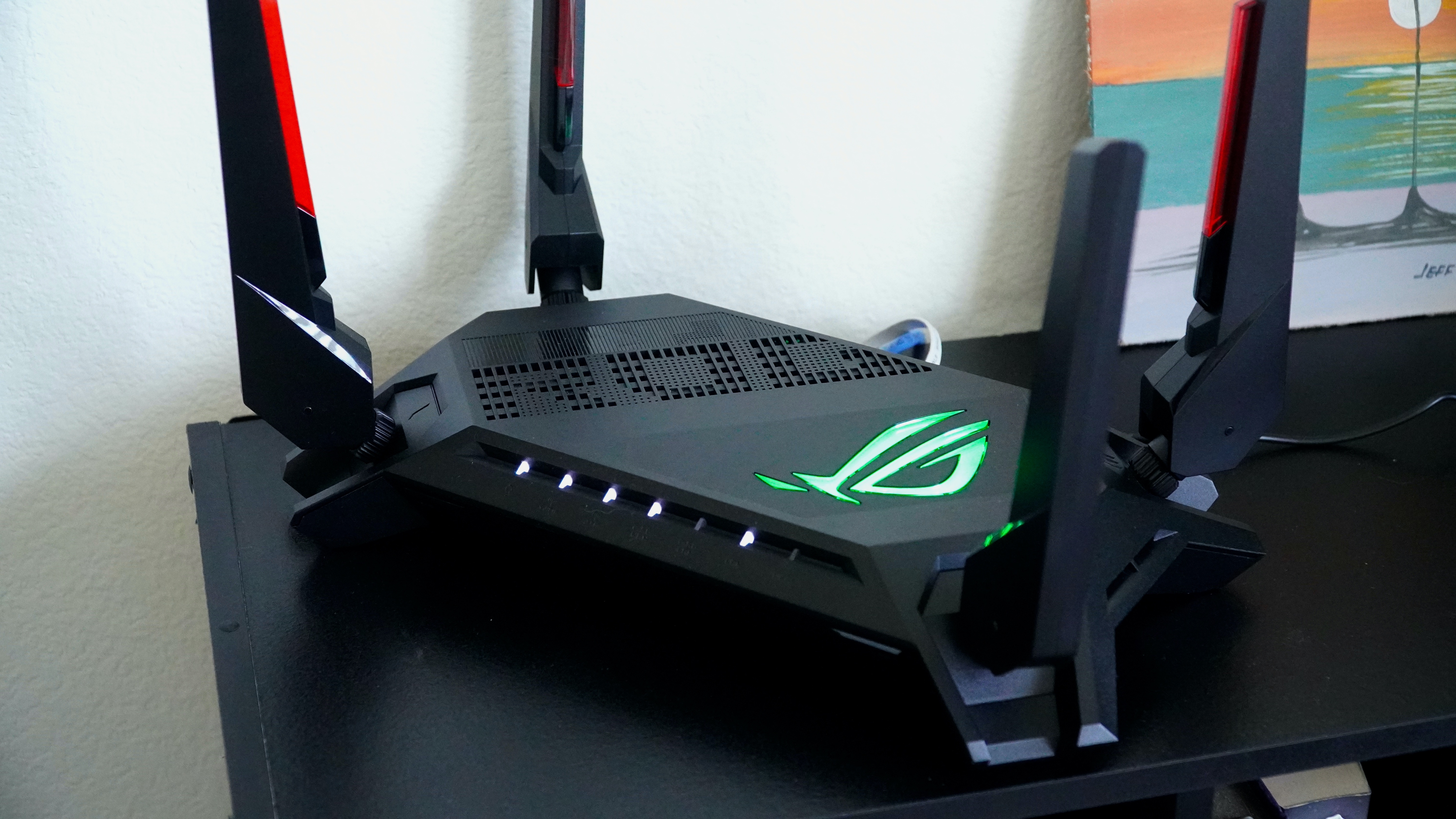
You should buy it if...
- You need fast wired connectivity in your home
- You share your gaming connection with other people
- You need good parental controls and network security
- You like things with red plastic accents and RGB lighting (everybody's different)
You shouldn't buy it if...
- You're looking for the best AX6000 wireless value
- You want something with a subtle design
The ROG GT-AX6000 is a powerful router with a handful of unique features. This router is great for the gamer that has moved up to multi-gigabit ethernet and is powerful enough to handle large file transfers to a home NAS with multi-gigabit support. While not everyone needs these features, those who do will find this router's performance excellent and the software to be more customizable than just about any of its peers. Plus, if you don't want to get into the weeds with the settings, most people will be plenty happy with the options in the Asus Router app.
There are cheaper gaming routers available, including some from Asus and ROG, that will get the job done for most gamers. The GT-AX6000 just takes things to the next level and adds features only seen in the highest-end equipment with such ease that you might forget they're there. All of this without a hitch in performance, no need for resets despite my incessant tinkering, and Ethernet options that had me pricing multi-gigabit LAN adapters for my PC.
This router is hard to recommend to most people due to its price, but after using it for a while, I really don't want to move on to the next router.
When Samuel is not writing about networking or 5G at Android Central, he spends most of his time researching computer components and obsessing over what CPU goes into the ultimate Windows 98 computer. It's the Pentium 3.
